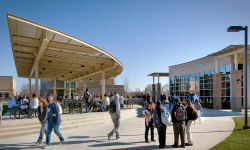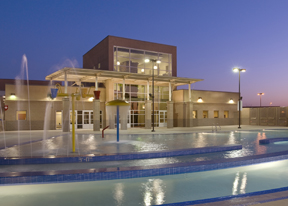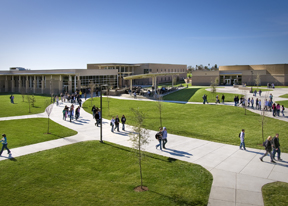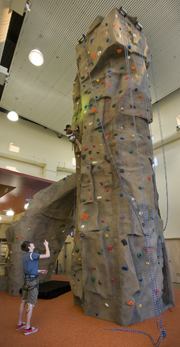Mutual Benefit
 Not long ago, there was trouble, right here at River City High School. The campus in West Sacramento, a suburb of California’s capital nestled near the banks of the Sacramento River, was serving nearly twice as many students as it was built to accommodate.
Not long ago, there was trouble, right here at River City High School. The campus in West Sacramento, a suburb of California’s capital nestled near the banks of the Sacramento River, was serving nearly twice as many students as it was built to accommodate.
At the same time, the city’s parks and recreation department was looking for development options for a part of the city that had experienced impressive residential and commercial growth, but had limited indoor recreational facilities for the community.
Instead of planning separate projects, the two organizations worked together to create a joint-use facility that is as equally beneficial for residents as it is for students.
From Old to New
Anything short of new construction was not an option for the high school.
“We were jammed in there like proverbial sardines,” says Stuart MacKay, principal of the school.
 “Our gym looked like an old aircraft hanger,” MacKay says. “We had a fire in one of the closets that was built with old plasterboard, and it was absolutely amazing that it didn’t just go up in smoke.”
“Our gym looked like an old aircraft hanger,” MacKay says. “We had a fire in one of the closets that was built with old plasterboard, and it was absolutely amazing that it didn’t just go up in smoke.”
As the district worked to secure funding for a new campus, Bob Jonhston, director of the city’s parks and recreation department, was evaluating recreation needs for the more than 40,000 people who live in the city.
“One of the things that was key in the master plan — and as we started to assess the needs of the city — was the need for an indoor recreation center,” Johnston says.
Eventually, the two organizations met to discuss potential joint-use options with the city architect, the district’s architect, the superintendent and representatives from the parks and recreation department.
“The city was involved pretty early in the design phase, but there was some back and forth,” says Richard Parks, the educational facility group leader for DLR Group, the district’s architect. “We were designing this joint-use community center before there was an actual joint-use agreement in place.”
 |
Under the deal, the city leases the recreation center from the school and manages it with a membership-based business plan. A fiscal analysis revealed that a similar facility on city-owned land would have cost $8 million more, according to Johnston.
Separate, but Equal
The facilities, which completed in December 2008, create a new image for the high school and the parks and recreation department.
The department now has a facility that is comparable to a high-end private sector health center. Its waterslides are visible from the roadway and a climbing wall dominates the interior space adjacent to the lobby. A glass-enclosed cardio center, a weight room and a dance space are  also located at the facility.
also located at the facility.
The high school also has increased visibility in the community. Instead of being a separate, isolated campus, residents who would have no other reason to be near the school are visiting the abutting recreation center every day.
“It added some challenges, but it also adds some opportunities,” Parks says. “It’s pretty exciting to be able to leverage a project and engage more users. It really expands the services that the high school can contribute to the community. It sort of goes back to the traditional model of the school as the center of the community.”
The new facilities have been a boon for both organizations. The recreation center has had 15,000 membership activations since it opened.
“We really didn’t expect that,” Johnston says. “We expected 5,000 to 7,000 open accounts.”
At the high school, students and staff are greeted with an expansive campus composed of several buildings that surround a central courtyard, outdoor eating and relaxation areas and circulation paths.
“The improved environment has definitely helped improve the culture and perspective on campus,” MacKay says. “The kids get along better because there is more space. It’s just a much more pleasant place to be.”
The media area includes a student-broadcasting program with live broadcasting capabilities to every classroom and green-screen technology.
“The first teacher that we had for the program works for Channel 13 in Sacramento,” MacKay says. “He said it looked just like the TV studio in which he works in.”
“We really didn’t expect that,” Johnston says. “We expected 5,000 to 7,000 open accounts.”
 At the high school, students and staff are greeted with an expansive campus composed of several buildings that surround a central courtyard, outdoor eating and relaxation areas and circulation paths.
At the high school, students and staff are greeted with an expansive campus composed of several buildings that surround a central courtyard, outdoor eating and relaxation areas and circulation paths.
Interior spaces offer a mix of standard classrooms, labs and dining areas, along with a fully functional media center and black box theater.
“The improved environment has definitely helped improve the culture and perspective on campus,” MacKay says.
“The kids get along better because there is more space. It’s just a much more pleasant place to be.”
The media area includes a student-broadcasting program with live broadcasting capabilities to every classroom and green-screen technology.
“The first teacher that we had for the program works for Channel 13 in Sacramento,” MacKay says. “He said it looked just like the TV studio in which he works in.”
Growing Pains
Although the new facilities helped create efficiencies and maximize resources, stakeholders were challenged with creating a mutual understanding of how the facilities would be operated.
“Is it perfect from an operational standpoint? Probably not,” Johnston says. “But in today’s economy — trying to squeeze as much value out of the dollar — it’s probably worth some sacrifices.”
After the facility opened, scheduling proved to be one of the greatest challenges, with the city’s various community sports teams and the high school sports teams competing for shared gym and field space.
A protocol for paying expensive utility and cleaning bills also had to be negotiated — not an easy task considering the variable operational hours between the two organizations.
The relationship between the two entities continues to solidify as officials build trust and make compromises to resolve other issues, MacKay says.
“We sit and talk about it and see where the areas of weakness are,” he says. “We try to work out an accommodation that we both can live with.”
At the end of the day, Johnston, who has worked with recreational facilities for 30 years, says the approach offers a much better use of space compared to traditional operational models.
“Facilities get duplicated,” Johnston says. “Schools go out and build facilities, then cities go out and build them. No matter where you are, there is always downtime. If you really look at how a lot of these facilities are programmed, a lot of them sit empty a lot of the time.”
Parks, who tours campuses and attends school construction industry events across the country, says the joint-use model is becoming more common and will continue to grow.
“We are seeing more and more, and it’s starting to expand,” Parks says. “Traditionally, it was just athletic facilities. Now, we are starting to see libraries, continuing-education facilities and special-education facilities. It’s exciting.”
Furnishings/Equipment/Materials
